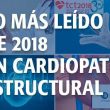iFR is a safe alternative for lesion deferral even when it comes to the left anterior descending artery (LAD). What is more, patients deferred with iFR showed significantly fewer events than patients deferred using FFR. Neither clinical cardiologists nor interventionists feel comfortable deferring LAD treatment, because it is often perceived as high risk. If functional<a href="https://solaci.org/en/2019/02/07/clinical-events-after-deferral-of-lad-treatment-guided-by-ffr-or-ifr/" title="Read more" >...</a>
Optimal Revascularization Time in Transient STEMI
Patients admitted with transient ST elevation MI and later normalize completely (symptimos disappear before being treated) are those we normally say are “undergoing a non-ST elevation MI”. This is complex, because revascularization time remains nuclear, as is whether to treat them as STEMI or non-STEMI patients. The aim of this study was to determine the<a href="https://solaci.org/en/2019/01/31/optimal-revascularization-time-in-transient-stemi/" title="Read more" >...</a>
The Most Important Articles of 2018 in Structural Heart Diseases
1- ESC 2018 | MITRA FR: Testing MitraClip for Secondary Mitral Regurgitation In secondary mitral regurgitation, mitral-valve leaflets and chordae are structurally normal and mitral regurgitation results from alterations in left ventricular geometry and function. Read more 2- TCT 2018 | COAPT: MitraClip in Patients with Secondary Mitral Regurgitation The prognosis of patients with<a href="https://solaci.org/en/2019/01/18/the-most-important-articles-of-2018-in-structural-heart-diseases/" title="Read more" >...</a>
TAVR Is Feasible and Offers Good Outcomes in Patients with Cancer
Courtesy of Dr. Carlos Fava. Oncology patients have been excluded from all studies, but many of them have a life expectancy of over a year or two, and aortic stenosis can pose a problem as regards their treatment. This study analyzed 2744 patients who underwent TAVR. Among them, 222 presented cancer (8.1%). Patients with cancer were younger,<a href="https://solaci.org/en/2019/01/16/tavr-is-feasible-and-offers-good-outcomes-in-patients-with-cancer/" title="Read more" >...</a>
Acute Coronary Syndromes After TAVR: Frequent and Not All Undergo Coronary Angiography
Approximately 10% of patients who undergo transcatheter aortic valve replacement (TAVR) are readmitted for an acute coronary syndrome after a mean follow-up of 25 months. Male sex, prior coronary artery disease, and (surprisingly and hard to explain) nontransfemoral approach were independent predictors of acute coronary syndrome after TAVR, an event associated with high midterm mortality. While<a href="https://solaci.org/en/2019/01/04/acute-coronary-syndromes-after-tavr-frequent-and-not-all-undergo-coronary-angiography/" title="Read more" >...</a>
The 10 Most Read Articles of December
1- Everolimus-Eluting Stents Finally Have a Rival and Not Just a “Non-Inferior” Stent In this large randomized trial, there were significant differences as regards both target-lesion failure and target-vessel-related infarction, which persisted through a 2-year follow-up and favored treatment with an ultrathin-strut bioresorbable-polymer sirolimus-eluting stent (Orsiro) compared with the gold standard, a durable-polymer everolimus-eluting stent<a href="https://solaci.org/en/2019/01/04/the-10-most-read-articles-of-december/" title="Read more" >...</a>
Balloon-Expandable vs. Self-Expanding: To Each Valve Its Own Annulus
The former generation of valves, the balloon expandable (Sapien XT), was associated to less paravalvular leak than the self-expanding valves only in patients with larger annuli. The new generation of self-expanding valves (Evolut R) has managed to significantly improve sealing in patients with larger annuli and still holds potential benefits for smaller annuli. The aim<a href="https://solaci.org/en/2018/12/28/balloon-expandable-vs-self-expanding-to-each-valve-its-own-annulus/" title="Read more" >...</a>
Is TAVR at Hospitals Without Backup Cardiovascular Surgery Feasible?
Patients undergoing transcatheter aortic valve replacement (TAVR) at hospitals without cardiovascular surgery available are at significantly higher risk. That in itself is a call for attention; however, a propensity-matched analysis shows that the short- and long-term mortality rates are similar among patients treated at hospitals with and without cardiovascular surgery backup. This debate emerged a<a href="https://solaci.org/en/2018/12/03/is-tavr-at-hospitals-without-backup-cardiovascular-surgery-feasible/" title="Read more" >...</a>
Differences in Stroke between TAVR and SAVR in Intermediate Risk Patients
Transcatheter aortic valve replacement (TAVR) is more and more frequent in lower risk populations that had previously been treated with surgical valve replacement (SAVR). A small difference in neurological events could have significant consequences when it comes to deciding a course of action. This study is a sub-analysis of the randomized study SURTAVI (Surgical Replacement<a href="https://solaci.org/en/2018/11/09/differences-in-stroke-between-tavr-and-savr-in-intermediate-risk-patients/" title="Read more" >...</a>
TAVR in Low-Risk Patients with “Zero” Mortality and “Zero” Stroke
Transcatheter aortic valve replacement (TAVR) is now the standard of care for patients with symptomatic severe aortic stenosis who are at extreme, high, or intermediate risk for surgery. This multicenter, prospective study (Feasibility of Transcatheter Aortic Valve Replacement in Low-Risk Patients With Symptomatic, Severe Aortic Stenosis) included low-risk patients and was approved by the United<a href="https://solaci.org/en/2018/11/09/tavr-in-low-risk-patients-with-zero-mortality-and-zero-stroke/" title="Read more" >...</a>









